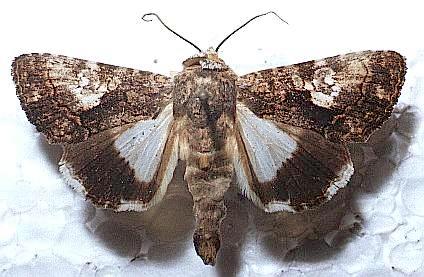
| Eastern Alchymist or Sweet Potato Leaf Worm (one synonym : Catephia ramburii Boisduval, 1829) ACRONICTINAE, NOCTUIDAE, NOCTUOIDEA | (donherbisonevans@yahoo.com) and Stella Crossley |


| Eastern Alchymist or Sweet Potato Leaf Worm (one synonym : Catephia ramburii Boisduval, 1829) ACRONICTINAE, NOCTUIDAE, NOCTUOIDEA | (donherbisonevans@yahoo.com) and Stella Crossley |

The Caterpillar of this species is grey with darker grey mottling and with a broad pale yellow stripe running along each side, and orange lateral lines running above and below these broad stripes. There is sometimes a pale patch on the last abdominal segment, and two prominent black spots on the second abdominal segment. The caterpillar feeds on a number of plants from the Bindweed family (CONVOLVULACEAE), including :
and is sometimes a pest on:
The caterpillar has also been found on:
The caterpillar grows to a length of about 5 cms. It pupates in a cell in the soil. Specimens pupating in late April in Melbourne emerged as adult moths about eight months later.

The adult moth is sooty black, with a light grey patch on the fore wings containing a pattern like an opening flower bud. The hind wings each have a white basal area and a white tornus and termen. The moth while at rest, displays these white patches by opening and closing its wings. The undersides of the wings have white basal areas, and the fore wings each have a crescent-shaped black discal dot.
The pheromones of the species and the courtship behaviour have been studied. The species is attacked by Entomophaga aulicae (Fungus).

The species is found over much of the world, for example :
The subspecies acronyctodes Guenée, 1852, is found over much of Australia, including
The placement of this genus Aedia, into a subfamily is the subject of some controversy. Various authors place it in
Further reading :
David Carter,
Butterflies and Moths,
Collins Eyewitness Handbooks, Sydney 1992, p. 262.
Ian F.B. Common,
Moths of Australia,
Melbourne University Press, 1990, fig. 45.14, p. 451.
Achille Guenée,
Noctuélites III,
in Boisduval & Guenée:
Histoire Naturelle des Insectes; Spécies Général des Lépidoptères,
Volume 9, Part 7 (1852), pp. 47-48, No. 1378.
Carl Linnaeus,
Insecta Lepidoptera,
Systema Naturae,
Volume 1, Edition 10 (1760), Class 5, Part 3, p. 518, No. 121.
Peter B. McQuillan, Jan A. Forrest, David Keane, & Roger Grund,
Caterpillars, moths, and their plants of Southern Australia,
Butterfly Conservation South Australia Inc., Adelaide (2019), p. 163.
Peter Marriott,
Moths of Victoria - Part 9,
Cutworms and Allies - NOCTUOIDEA (C),
Entomological Society of Victoria, 2020, p. 5.
 caterpillar |  butterflies |  Lepidoptera |  moths |  caterpillar |
(updated 15 May 2010, 10 May 2025)